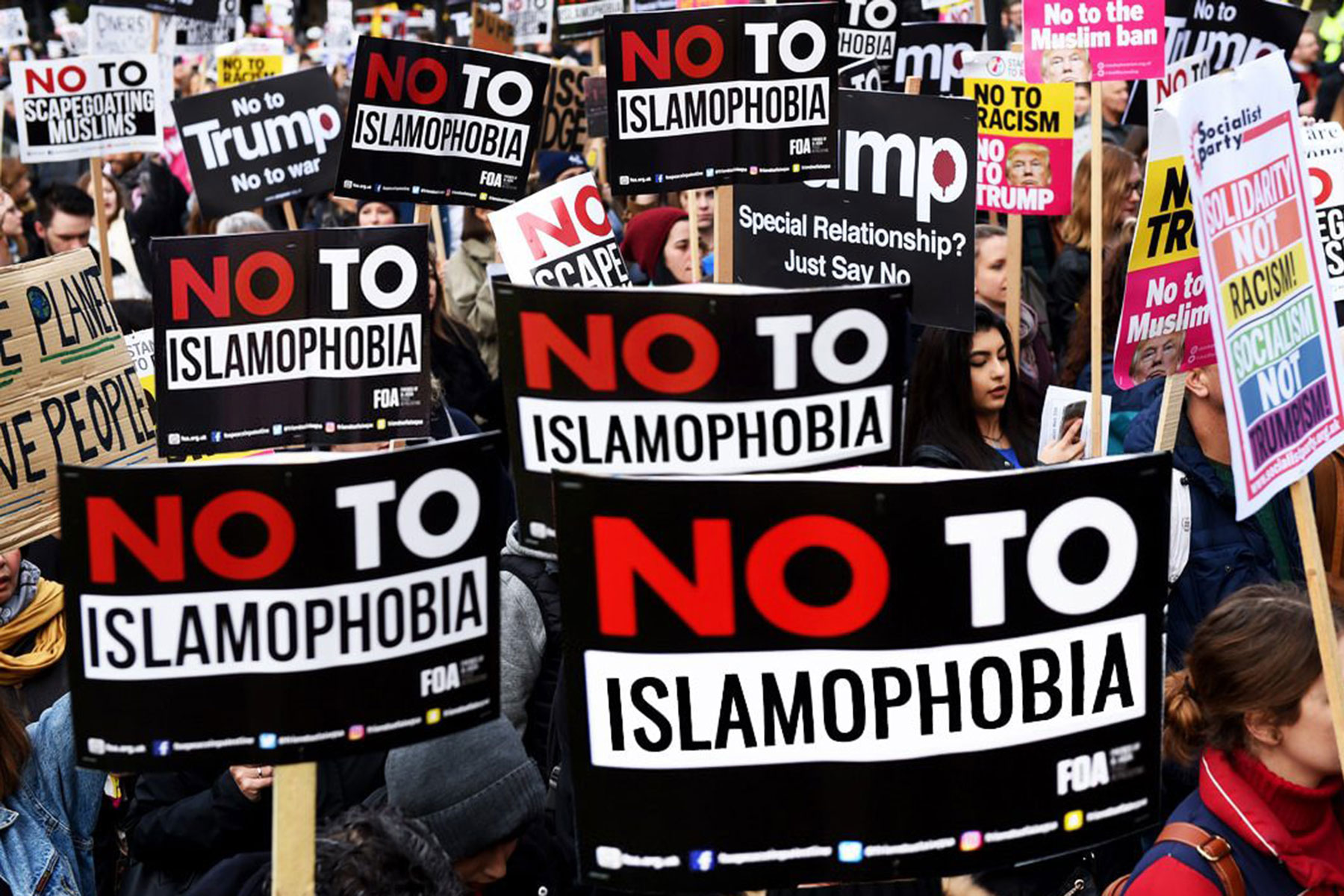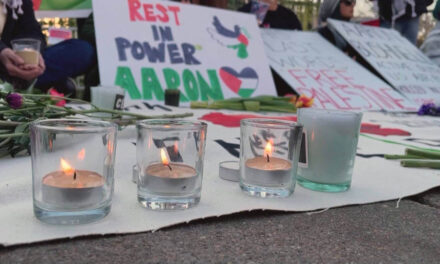
There’s a common perception that Muslims pose a threat to the security of the U.S., but the real threat is to them.
June 2018 was an especially bad month for the status of Muslims in America. First, we learned that a new study showed that many Americans view Muslims in the United States as insufficiently “American,” and almost 20 percent would deny Muslim citizens the right to vote. Then, the Supreme Court upheld President Donald Trump’s decision to institute a ban on immigrants, refugees and visa holders from five majority-Muslim countries in a 5-4 decision.
The synergy of these two pieces of information is critical because it reveals a common attitude that Muslims pose a threat to U.S. security whether they are U.S. citizens or not. And while these attitudes do break down heavily across party lines, it is noteworthy that the study of U.S. perceptions of Muslim Americans conducted by Dalia Mogahed and John Sides for the Voter Study Group indicated that even 12 percent of Democrats would consider denying Muslim citizens the right to vote. Their study also showed that 32 percent of Democrats favor targeting Muslims at U.S. airport screenings to ensure the safety of flights. That figure compares with 75 percent of Republicans.
Chief Justice John Roberts wrote the majority SCOTUS opinion upholding the travel ban. He emphasized that, despite ample evidence of President Donald Trump’s animus towards the Muslim community, the ban was a security issue and not an example of discrimination, “Because there is persuasive evidence that the entry suspension has a legitimate grounding in national security concerns, quite apart from any religious hostility, we must accept that independent justification.”
As made clear by Justice Sonia Sotomayor’s dissent, where she referenced the court’s 1944 decision to uphold the internment of Japanese Americans, the practice of claiming national security needs in order to implement discriminatory policy is nothing new in this country. She argued that the court’s decision “leaves undisturbed a policy first advertised openly and unequivocally as a ‘total and complete shutdown of Muslims entering the United States’ because the policy now masquerades behind a façade of national-security concerns.”
Taken together the Supreme Court decision and the voter study reveal a mainstreaming of Islamophobia. Whether aimed at Syrian refugees or U.S. citizens, these attitudes, policies and practices underscore the reality that America really has a Muslim problem — a problem seeing Muslims as human beings deserving of dignity, human rights and respect.
It should go without saying, but I’ll emphasize the point here, that the fears over threats posed by Muslims are simply not borne out by facts. At all.
White males pose the biggest threat to U.S. citizens, but no one is talking about taking away their right to vote. And as Margaret Sullivan reported for the Washington Post, 2017 was the deadliest year for civilian casualties in Iraq and Syria, with as many as 6,000 people killed in strikes conducted by the U.S.-led coalition — an increase of more than 200 percent over the previous year. That number is far worse if you add in countries like Yemen, Afghanistan, Somalia and others.
While bigotry toward a wide range of groups has been normalized in the Trump era, there are particular features of the targeting of Muslims as security threats that are noteworthy.
As Moustafa Bayoumi, author of “How Does it Feel to Be a Problem,” explained it to me, the key turning point was obviously the attacks of 9/11/2001. Since then, he said, there has “been a relentless drive to delegitimize Muslim American citizenship.” In addition, he pointed out that for many non-Muslim Americans, there is a tendency to think of a Muslim citizen as a Muslim first, rather than a fellow American, an attitude buttressed by the fact that “U.S. support for policies targeting Muslims has been substantial and consistent.”
But here’s the thing. Fear of Muslims was not simply a spontaneous response to the events of 9/11. The current attitude of suspicion, fear and intolerance of the Muslim community was purposefully orchestrated. A team of researchers that studied the roots of Islamophobia in the United Sates following 9/11, published as “Fear Inc.,” identified seven charitable groups that provided $42.6 million to Islamophobic think tanks between 2001 and 2009.
Their research was further able to show a direct line from Islamophobic think tanks, like the Richard Mellon Scaife foundation, to media influencers and politicians. They cite one example from 2010 when then Speaker of the House of Representatives Newt Gingrich warned a conservative audience at the American Enterprise Institute that the Islamic practice of Sharia was “a mortal threat to the survival of freedom in the United States and in the world as we know it.” Gingrich went on to claim that “Sharia in its natural form has principles and punishments totally abhorrent to the Western world.”
What they show, moreover, was that Gingrich’s remarks mimicked the language of conservative analyst Andrew McCarthy, who co-wrote a report calling Sharia “the preeminent totalitarian threat of our time.”
Today in the Trump era, the systematic production of Islamophobic stories discovered by the Fear, Inc. team of scholars seems quaint. Buzzfeed reporters Hannah Allam and Talal Ansari found that since 2015, Republican officials in 49 states have openly attacked Muslims with words and proposed legislation.
Critical in this new transition is not just the way that Islamophobia is acceptable within the Republican party and far too tolerable among Democrats, it is the way that it is now elected officials who are regularly and openly vilifying a group. “It has become an acceptable plank within the Republican Party to demonize Muslims,” explains Robert McCaw, government affairs director for the Council on American-Islamic Relations, or CAIR, the nation’s largest Muslim advocacy group. “Policymakers take ideas and turn them into action. That can endanger communities like American Muslims if Islamophobic sentiment is turned into law.”
One of the most concerning features of Islamophobia in the United States is the fact that, as Bayoumi explains, most Americans simply don’t know a Muslim. “The number of U.S. citizens who report even knowing a Muslim is quite small,” he explains. “This allows the media to play a major role in shaping public perception. In contrast, with many other ethnic groups, like Mexicans for instance, you often lack a real-life counterpart to Islamophobic ideology.”
The lack of actual experiences with any Muslims simply aids in the development of negative beliefs about an entire class of people. When I asked Sides why he and his colleague chose to test attitudes towards denying Muslim Americans the right to vote, he said that the idea was to gauge the degree to which those surveyed were able to see Muslims as actual citizens. The fact that about 1/5 of all Americans can’t do that is serious cause for alarm.
The inability of a significant part of the U.S. population to even recognize the legitimate rights of Muslim citizens stems directly from the fact that Muslims are consistently painted as a security threat — a characterization that dehumanizes them and make it much easier to implement discriminatory policies, practice bigotry and justify intolerance.
As Nour Kteily and Emile Bruneau found in a study of U.S. perceptions towards Mexicans and Muslims, “Americans blatantly dehumanized both Muslims and Mexican immigrants.” They further found “that the degree of blatant dehumanization was uniquely associated with support for exclusionary policies proposed by Donald Trump and some of his Republican peers.” They were also able to show that those attitudes directly led to more hostile and violent attitudes towards the dehumanized communities.
This series of connections explains why, for instance, we have had a rise in hate crimes towards Muslims living in the United States. A 2017 Pew Research study found that hate crimes against Muslims in the United States had surpassed post 9/11 levels.
The only explanation for that rise is the systemic effort to further alienate and disenfranchise Muslim Americans while also demonizing all Muslims across the globe.
And that is where the real threat lies. The combination of Islamophobic perceptions and policies that has swept the United States in the last years has created a hostile and threatening environment for Muslims. In a Pew Research Center survey conducted in early 2017, 75 percent of Muslim American adults say there is “a lot” of discrimination against Muslims. Moreover, half of U.S. Muslim adults say that in recent years it has become more difficult to be a Muslim in the United States.
All of this gets worse with the legitimization of Trump’s travel ban, which Bayoumi points out is also dividing families, sowing fear, and creating an atmosphere of insecurity and anxiety all of which is causing Muslim Americans to feel further alienated and marginalized.
The research by Kteily and Bruneau reveals an even more disturbing facet to the dehumanization of a minority community. They show that dehumanizing groups helps promote support for hostile policies targeted at these groups. But even worse, they also show that by making minorities feel dehumanized, “they also further the very danger they purport to safeguard against.” This means that hostile and violent perceptions and policies exacerbate and aggravate group conflict and potential for violence.
It is time to recognize that the real Muslim threat in this country is to their well-being. And until we take their security seriously, none of us will be safe.
Sophia A. McClennen
Originally published on Salon as America’s real Muslim problem is Islamophobia














